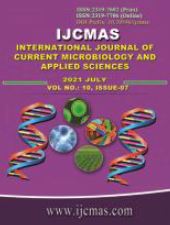


 National Academy of Agricultural Sciences (NAAS)
National Academy of Agricultural Sciences (NAAS)

|
PRINT ISSN : 2319-7692
Online ISSN : 2319-7706 Issues : 12 per year Publisher : Excellent Publishers Email : editorijcmas@gmail.com / submit@ijcmas.com Editor-in-chief: Dr.M.Prakash Index Copernicus ICV 2018: 95.39 NAAS RATING 2020: 5.38 |
The aim of this study is to compare the physicochemical and microbiological parameters of soya flour, but also to determine the origin of faecal contamination of the latter. To carry out the work, three types of flour consisting of 60 soybean samples were used. In addition, the method proposed by AOAC, (1995) made it possible to determine the physicochemical parameters such as dry matter, ash, pH, moisture content and titratable acidity dosage. The microbiological analyzes enabled the enumerations of yeasts and molds, fecal coliforms, aerobic mesophilic germs, Bacillus cereus, detection and enumeration of E. coli, Staphylococcus aureus and faecal streptococci. The determination of the origins of faecal contamination was carried out according to the work of Borrego and Romero (1982). The results show that there is no significant difference between the different types of flour at P> 0.05 at the 5% level for the different physicochemical parameters. However, at the level of microbiological parameters, a significant difference is noted between the F2 flour and the two other types, namely F1 and F3, at the level of Mesophilic Aerobic Germs, E. coli and Staphylococcus aureus. There is also a significant difference between the F3 flour and the two other types of flour namely the F 1 and the F2 at the level of Bacillus cereus. Furthermore, a significant difference is also noted between F1 flour and the two other types of flour, namely F2 and F3 in faecal streptococci. In addition, we see the source of contamination of F1 is of mixed origin, predominantly human, while F2 and F3 flour, the source of contamination is strictly human. Key words: comparison, origin, feces, streptococci, coliforms.
 |
 |
 |
 |
 |